Facial Implants
Conveniently located to serve Seattle and Bellevue
Jump To
What are facial implants?
As we age, the cheeks gradually lose fullness, the temples begin to hollow, and the folds beside the nose become more noticeable. Fortunately, there are several effective ways to restore this lost volume. These areas can be improved using injectable fillers (such as hyaluronic acid or Sculptra/PLLA), fat grafting, or facial implants.
Facial implants are used for both aesthetic enhancement and reconstruction in cases of congenital deformities, oncologic defects, or post-traumatic changes. They provide structural support to ptotic (sagging) soft tissues and help restore natural facial contours. Made of contourable and non-degradable materials, implants aim to create a smooth, natural appearance with improved fullness and reduction of deep folds such as the nasolabial folds (NLF). Common implant materials include polyethylene (Medpor), silicone, and Gore-Tex, all of which offer long-lasting results compared to temporary fillers. Silicone, in particular, is highly favored due to its excellent tissue compatibility, versatility, and ease of removal. It conforms well to facial structures, can be exchanged if needed, and provides better structural projection from bone than injectable fillers. The benefit of silicone implant results from its smooth, non-porous surface which reduces bacterial adhesion. Due to this, it also forms a capsule in the body which allows for ease of removal or exchange compared to Medpor or Gore-Tex materials that are porous. Overall, implants are effective for correcting tissue descent caused by aging, congenital anomalies, trauma, or chronic disease.
What are the differences between fillers, fat augmentation and facial implants?
Fillers, fat grafting, and facial implants all work to restore volume in the face, which naturally diminishes over time due to fat loss, collagen breakdown, and bone thinning. Each option replenishes fullness in a different way.
- Fat grafting is an excellent choice for patients who prefer to use their own natural tissue, offering the highest level of compatibility. However, the amount of fat available can be limited due to body habitus, and not all transferred fat survives, which may require more than one session to reach the desired result.
- Injectable fillers, such as hyaluronic acid, are ideal for patients seeking quick, minimally invasive enhancement with no downtime. The trade-off is that results are temporary, typically lasting 6–18 months, so maintenance treatments are needed yearly. While the initial cost is lower, repeat sessions can add up over time.
- Facial implants offer the most significant lifting and structural support, especially along the cheeks or jawline. Unlike fat or fillers, which are softer and more fluid, implants provide solid, long-lasting definition. Results are permanent, but the procedure is more technically demanding and usually requires general anesthesia for the most precise and natural placement.
| Facial Implant | Fat Grafting | Dermal Fillers (eg. Hyaluronic acid) |
|
|---|---|---|---|
| Longevity | Permanent | Semi-permanent (may lose volume overtime) | 6-12 months |
| Recovery | 2-3 mo (full result) | 1-2 weeks | < 1 week |
| Anesthesia | General anesthesia | Local or general anesthesia | Local anesthesia |
| Customizability | Can be custom made or carved | Depending on fat availability | Depends on filler viscosity |
| Reversibility | Yes | No | Yes |
| Maintenance | None | May need second session | Need maintenance yearly |
| Biocompatibility | Excellent | Best (own tissue) | Excellent |
| Risk | Implant displacement needing revision, infection | Fat may not survive, infection | Vascular occlusion or migration |
Who is a good candidate for facial implants?
- Healthy
- Wants a long lasting permanent solution
- Some patients metabolize fat augmentation and fillers in a matter of weeks.
- Lost structural support in the face
- Positive outlook and specific goal
- Realistic expectations
Mandibular Jawline angle implants
A well-defined mandibular angle plays a key role in facial attractiveness. In men, a prominent and widened jaw angle is strongly associated with strength and masculinity. In women, a cleaner transition between the jawline and neck helps create a sculpted, elegant contour. With age, the mandibular angle becomes greater which could contribute to jowling.
Ideal Jaw Proportions
- The jaw angle should sit well below the level of the ear, contributing to a long, refined side profile.
- A desirable mandibular angle is typically less than 105 degrees, creating a sharper corner rather than a soft curve.
- From the front, the bigonial width (distance between the jaw angles) should be equal to or slightly less than the bitemporal width, and just slightly narrower than the cheekbone width (bizygomatic width).
- The soft tissue outline of the jaw angle (gonion) should sit lateral to the neck, creating a distinct separation between the face and neck.
- A clean transition between the mandibular body and ramus is key to a youthful and athletic look.
Mandibular angle implants come in two primary styles depending on the desired aesthetic outcome:
- Widening Implants — These increase the distance between the jaw angles on front facing view, creating a broader and more powerful lower face.
- Vertical Lengthening Implants — These extend the jaw angle downward, creating a sharper, more defined jawline.
- Male focused designs: typically emphasize width and strength.
- Female focused implants prioritize refinement and length rather than bulk.
The surgery involves general anesthesia. Incisions are carried out inside the mouth. Final results are seen typically in 1~3 months.
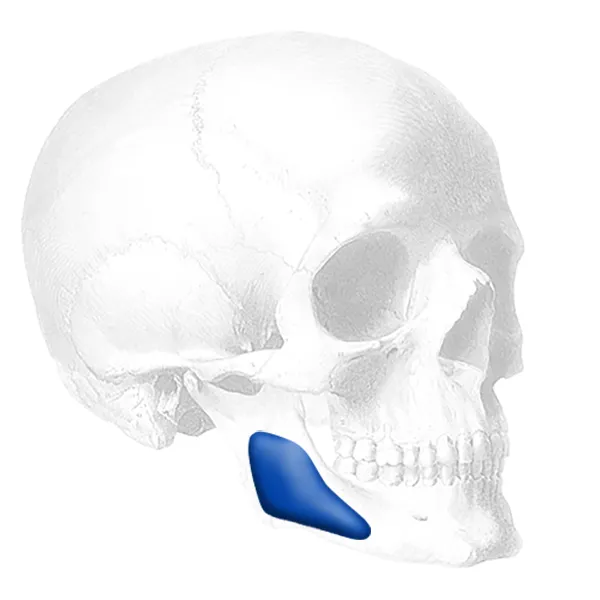
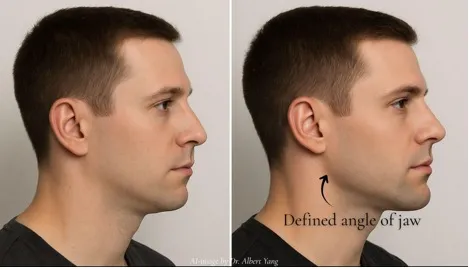
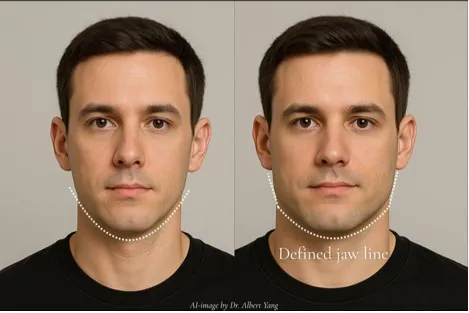
Midface implants
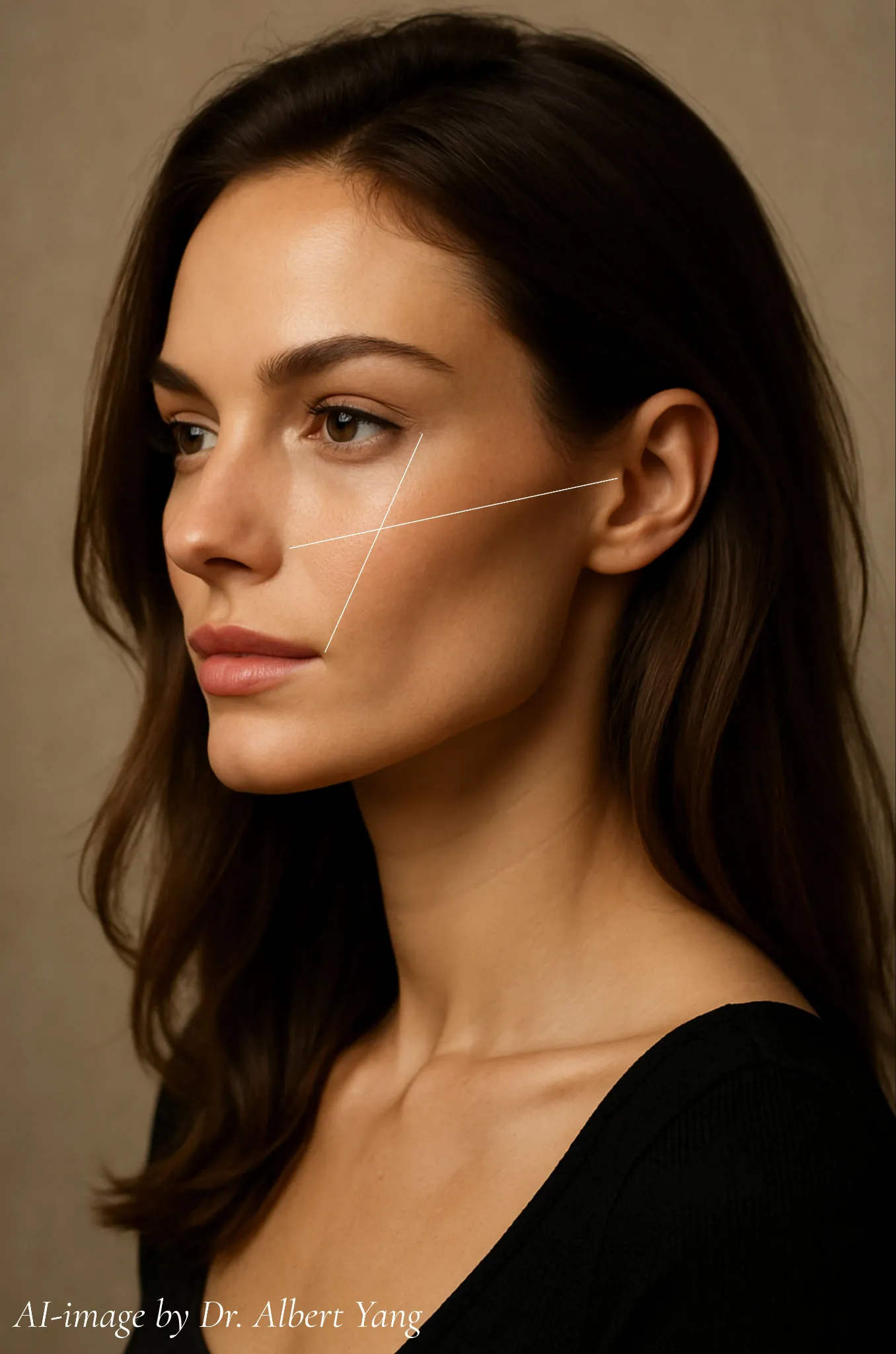 A full, rounded cheek is one of the strongest visual markers of youth and vitality. The ideal cheek contour is defined by the malar eminence, located at the intersection of two key facial lines: one from the oral commissure (corner of the mouth) to the lateral canthus (outer eye corner), and another from the nasal ala (side of the nose) to the tragus (ear cartilage) (see figure). When this high point is well-supported, the face appears lifted and refreshed.
A full, rounded cheek is one of the strongest visual markers of youth and vitality. The ideal cheek contour is defined by the malar eminence, located at the intersection of two key facial lines: one from the oral commissure (corner of the mouth) to the lateral canthus (outer eye corner), and another from the nasal ala (side of the nose) to the tragus (ear cartilage) (see figure). When this high point is well-supported, the face appears lifted and refreshed.
With aging, the skin becomes thinner and looser, while the underlying bone gradually resorbs, especially in the midface. This leads to flattening of the cheeks, deepening of the nasolabial folds, and the formation of tear trough hollows – often giving the face a tired look.
Midface implants are designed to reverse this by rebuilding lost projection and contour. They are available in three main styles depending on the type of deficiency:
- Malar Implants — Placed over the cheekbone to create anterolateral fullness
- Ideal for patients with bony hypoplasia or naturally flat cheek structure.
- Submalar Implants — Positioned under the cheekbone, increasing forward (anterior) projection
- Ideal to correct Type 2 deformities, where bone is normal but soft tissue volume has been lost.
- Combined Malar–Submalar Shell Implants — Used for Type 3 deformities, where both bone and soft tissue are deficient. These can be paired with facelift procedures for full rejuvenation.
The surgery involves general anesthesia. Incisions are carried out inside the mouth. Final results are seen typically in 1~3 months.
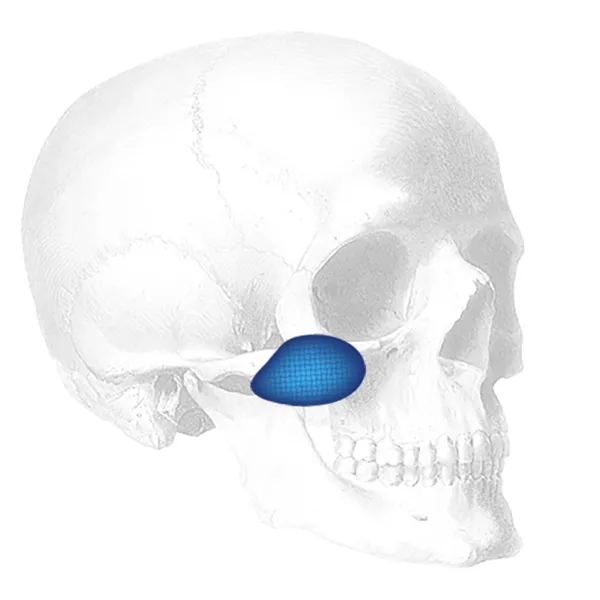
Temporal implants
The temples often lose volume with aging, weight loss, or genetics, leading to a hollow or concave appearance. While this change is subtle, it can make the face look tired, angular, or even skeletal, especially in lean individuals. In women, temple hollowing can disrupt the smooth contour between the forehead and cheek, while in men, it can create an overly sharp or aged look.
Temporal implants are designed to restore soft transition between the temple region to the cheek to improve overall facial harmony.
The procedure is typically performed through a hidden incision within the hairline. Final results are typically seen within 1-3 months.
Anesthesia
It is generally recommended that patients undergo general anesthesia for the procedure in order for proper placement of the implant.
What is the recovery
1–2 Weeks (Early Recovery Phase): Swelling, numbness, and mild discomfort are common — especially around the implant area.
- Most patients feel well enough to resume light daily activities after 1 week.
- Your doctor may prescribe or recommend the following during this phase:
- Antibiotics
- Antibacterial mouth rinse
- Cold compresses or icing
- Bandages or facial taping
- Oral pain medication
- Soft diet
1-2 months (Improvement phase): Swelling and numbness will continue to improve, facial contours become more refined. Light exercise can be resumed but contact sports or activities that could impact the face should still be avoided.
3 month and beyond (final phase): Generally at this time the final results can be seen and minor adjustments (if needed) can be considered
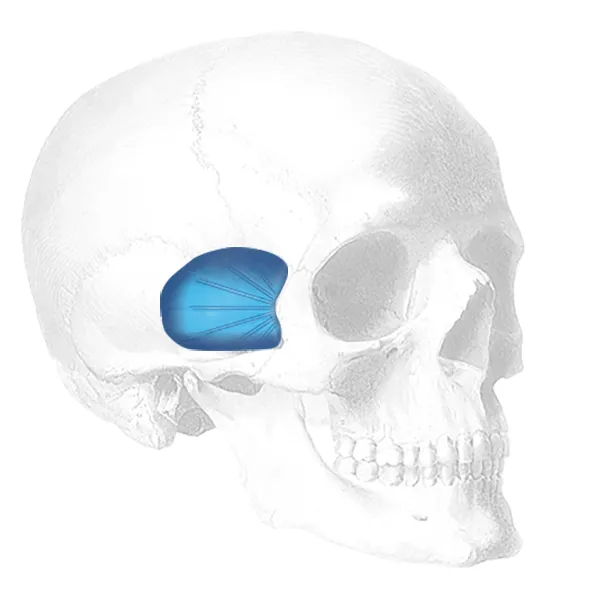
Possible complications of facial implants
Facial implant surgery is generally safe when performed by an experienced surgeon, but like any procedure, it does carry some risks. Potential complications include:
- Facial numbness
- Infection
- Implant shifting / asymmetry
- Pain
- Implant extrusion (rare)
- Bone resorption (minor, can happen with silicone implant)
